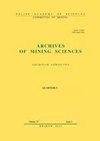Wedge Failure Analysis and Remedial Measures in Large Unlined Rock Cavern: a Case Study
IF 1.2
4区 工程技术
Q3 MINING & MINERAL PROCESSING
引用次数: 1
Abstract
This article presents a case study of a large wedge failure. It took place during excavation of the last bench of storage cavern with an approximate dimension of 80 m long having a depth of 8 m. The adopted intervention followed a structured approach, which included immediate rock support, geotechnical and geological investigations in the failure zone and design modifications. Back analyses of the failure zone were also carried out to assess design parameters with observed geological conditions. Re assessment in the failure zone was carried out using modified design parameters, which included shorter benches, rock support installation schemes such as longer rock bolts, reinforced ribs of shotcrete and reduced construction advances. Geotechnical monitoring in and around failure zone were carried out for recording any alarming movements in the rock mass. Initially, geotechnical monitoring was carried out in the recently excavated zone of the cavern on a daily basis. Based on continuous monitoring data for at least one week, the frequency of subsequent monitoring can be decided. In most cases the deformation of rock mass was considerably less than the alarming values which were calculated based on detailed design for different rock classes. The paper discusses the failure, investigation, cause, assessment and remedial measures to complete the construction of cavern.大型无衬砌岩洞楔块破坏分析及修复措施研究
本文介绍了一个大型楔块破坏的案例研究。它发生在储存洞穴最后一个台阶的开挖过程中,该台阶的尺寸约为80米长,深度为8米。所采取的干预措施遵循结构化方法,包括立即进行岩石支护、在破坏区进行岩土工程和地质调查以及设计修改。还对失效区进行了反分析,以根据观测到的地质条件评估设计参数。使用修改后的设计参数对破坏区进行了重新评估,其中包括较短的台阶、较长的岩石锚杆等岩石支护安装方案、喷射混凝土加固肋和减少的施工进度。在破坏区及其周围进行岩土工程监测,以记录岩体中的任何警报运动。最初,每天在洞穴最近开挖的区域进行岩土监测。根据至少一周的连续监测数据,可以决定后续监测的频率。在大多数情况下,岩体的变形远小于根据不同岩石类别的详细设计计算的警报值。本文论述了完成洞室施工的失败、调查、原因、评价及补救措施。
本文章由计算机程序翻译,如有差异,请以英文原文为准。
求助全文
约1分钟内获得全文
求助全文
来源期刊

Archives of Mining Sciences
工程技术-矿业与矿物加工
CiteScore
2.40
自引率
16.70%
发文量
0
审稿时长
20 months
期刊介绍:
Archives of Mining Sciences (AMS) is concerned with original research, new developments and case studies in mining sciences and energy, civil engineering and environmental engineering. The journal provides an international forum for the publication of high quality research results in:
mining technologies,
mineral processing,
stability of mine workings,
mining machine science,
ventilation systems,
rock mechanics,
termodynamics,
underground storage of oil and gas,
mining and engineering geology,
geotechnical engineering,
tunnelling,
design and construction of tunnels,
design and construction on mining areas,
mining geodesy,
environmental protection in mining,
revitalisation of postindustrial areas.
Papers are welcomed on all relevant topics and especially on theoretical developments, analytical methods, numerical methods, rock testing, site investigation, and case studies.
 求助内容:
求助内容: 应助结果提醒方式:
应助结果提醒方式:


